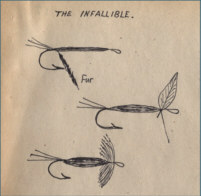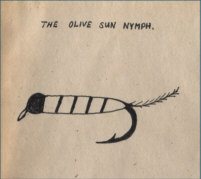Favourite Flies for the River Clyde (continued)
LARGE DARK OLIVE (wet fly)
Hook:
Size 12 or 14
Body:
Heron's herl dyed in picric acid, or yellow silk, and ribbed fine
gold wire
Hackle:
A normal, olive hackle wound on thinly
Wings:
Dark Starling
For the dry fly pattern, use a blue dun
hackle instead of the starling wings. Both the olive and blue dun hackle should
be combined evenly, and should be stiff enough for the fly to sit up in the
water. On the whole I have found the dry fly to be better than the wet,
particularly when there is a good hatch.
THE JOHN STOREY
Silk:
Black
Body:
Copper coloured peacock herl
Hackle:
Rhode Island red dark red cock hackle
Wings:
Small whole breast feather of the mallard, from an adult bird
THE INFALLIBLE
| This is a Devon pattern, which first came
to my notice many years ago. The fly's name intrigued me, since it suggests a
fail-me-never and every angler worth his salt is always on the lookout for a
pattern that will never let him down. The Infallible, which is suggestive of the
Iron Blue Dun, may not always live up to its descriptive title, but it does
catch a lot of fish wherever hatches of Iron Blues occur. For the dry fly, make
the body of mole fur or crimson tying silk, which may be shown in the tail end
of the body if the mole fur is used. |
 |
Hook:
Size 15 or 16
Body:
Mole or crimson tying silk
Hackle:
Whisks or setae are of dark blue dun cock
WHITE MOTH
Silk:
Black thread
Tail:
Whisks from white pheasant tippet feathers
Body:
White cock hackle tied palmer
Hackle:
White turkey neck feather
THE OLIVE SUN NYMPH
By Richard Walker
This simple Olive Sun Nymph catches trout
in a variety of circumstances, but I have found it especially useful in the
conditions implied in its name, that is in bright sunshine, whether the surface
is broken or calm, using a floating line and long leader.
|
Hook:
Size 12 or 14
Body:
Greenish-yellow daylight fluorescent floss tied thin
Rib:
Fine gold thread
Head:
A few turns of peacock herl
Tail:
A golden pheasant topping
|

|
|
|
Next page
|